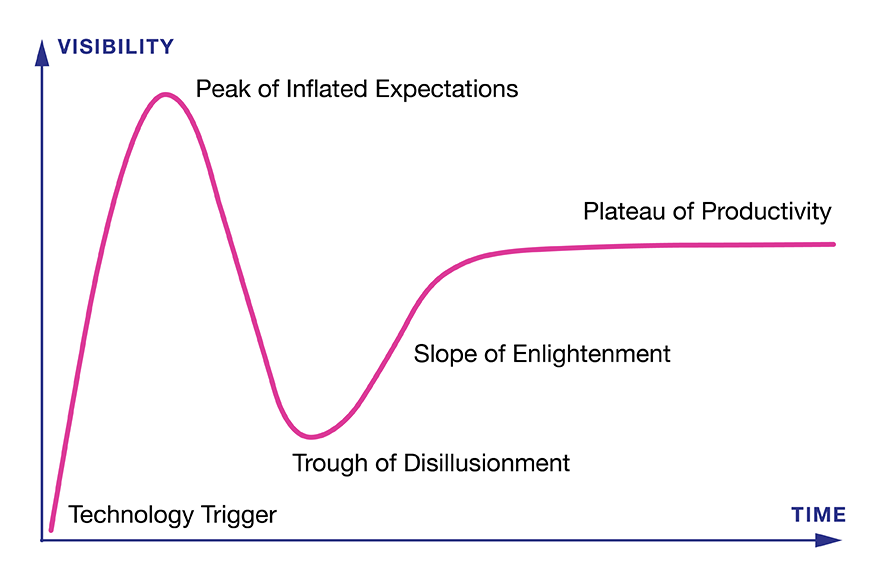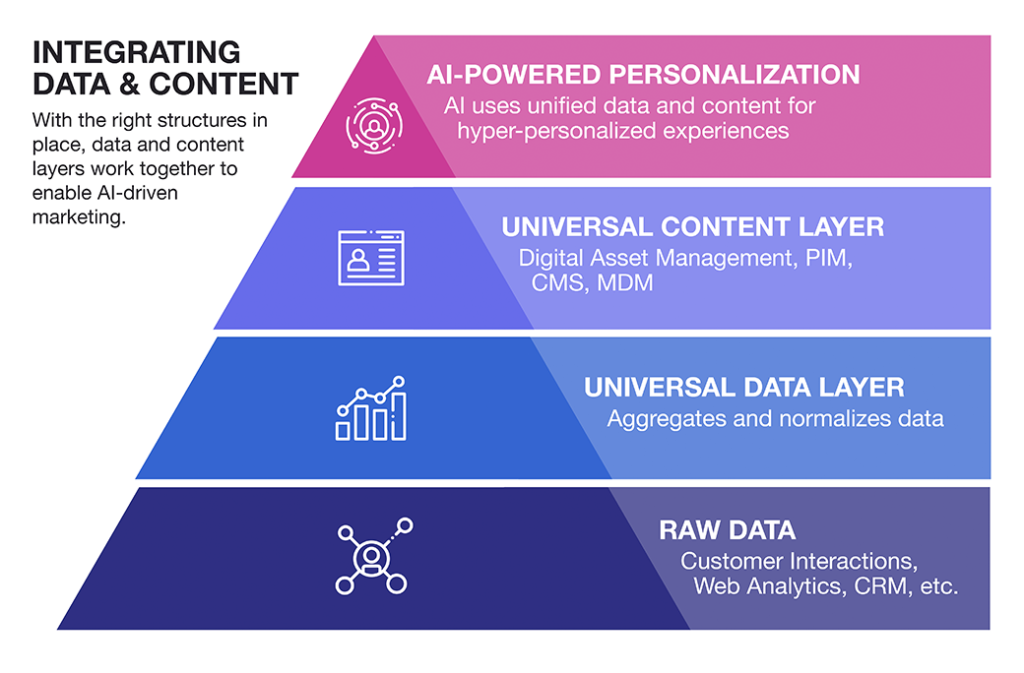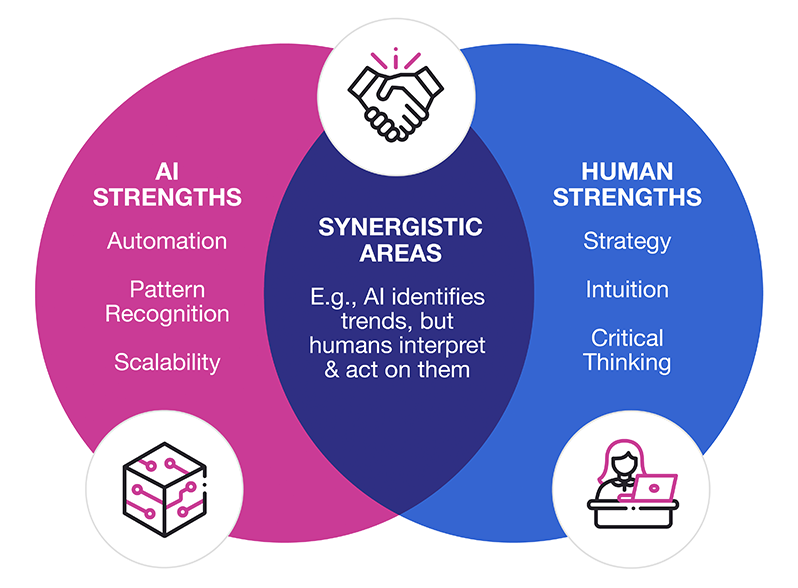The relationship between AI and digital analytics is evolving so rapidly that distinguishing real transformation from temporary hype is increasingly difficult. Discussions often risk overstating AI’s current impact while underestimating its long-term potential—a classic case of Amara’s Law.

So, how should you approach technology in this state of flux? A well-thought-out, pragmatic strategy is key. Rather than making big bets on individual AI features or narratives, focus on the fundamentals—core principles that will remain essential no matter how AI evolves. To fully capitalize on the inevitable technological shifts ahead, 2025 must be the year you reimagine your business’s relationship with customer data and analytics.
The path forward isn’t about simply collecting more data—it’s about capturing the right data, ensuring its accuracy, and building a resilient customer data infrastructure that empowers both artificial and human intelligence to excel. Customer data management and AI in customer service will play an increasingly critical role in driving meaningful insights and smarter decision-making.
Getting the Right Data: Quality Over Quantity
More than a decade ago, I had a conversation with a client that I’ll never forget. We were discussing which data would be most valuable for improving their digital experience. Looking for a way to save time and effort, they confidently stated that the answer was simple: Instead of worrying about which data points mattered, we could just collect everything—every customer action, every interaction—and let machine learning do the rest. According to their logic, the more data we fed into the model, the better the insights, and with just a few clicks, we’d instantly know which website changes to make.
It goes without saying that while AI can process vast amounts of data faster than humans, more data doesn’t always lead to better outcomes. In fact, it often leads to more noise. Irrelevant data can skew results, leading to misleading analyses rather than actionable customer insights.
AI won’t magically fix cluttered, low-quality data, and wasted effort on irrelevant inputs will only slow you down. Data is infinite, but resources aren’t—make every data point count.
Customer data collection must always have a clear purpose. Every piece of data you collect needs to be stored, maintained, and evaluated for accuracy. Too much irrelevant information increases the likelihood of spurious correlations. Now, imagine the damage when that data isn’t just irrelevant—but inaccurate. (More on that later.)
So what are your guiding principles for getting the right data in 2025?
1. Anchor to the Customer Journey
We live in an experience economy—one where consumers prioritize seamless, connected interactions. Studies show that 86 percent of consumers are willing to pay a premium for a more integrated ecosystem. Your company’s digital experience should be tailored to your unique business strategy, and your customer journey analytics should be the foundation of your customer data capture solutions. Use it as the filter for every data collection decision.
Start by mapping your customer journeys and documenting all major touchpoints and key moments. This will help you identify what you already know, what you don’t know, and where gaps exist in your customer data strategy.
Most importantly, focus on data that directly informs meaningful outcomes. Ask yourself: If this number increased or decreased by 200 percent overnight, how would I react? What decisions would I make based on that change? If you don’t have a clear answer, think twice before investing valuable resources in capturing that data.
2. Prioritize the Highest-Quality Data Sources
With the ongoing decline of third-party cookies, there’s no time to waste on data sources of diminishing value. Instead, focus on first-party and zero-party data—the most reliable, privacy-compliant sources available.
As you map your customer journey, carefully track where each metric, dimension, and user ID originates. Then, systematically replace all third-party data dependencies with customer data infrastructure you can—and should—own. Not only will this give you greater control, but it will also make compliance with GDPR and other customer data privacy regulations more manageable.
Prioritizing the right data in 2025 will help eliminate unnecessary bloat, making your system leaner and more agile. AI won’t magically fix cluttered, low-quality data, and wasted effort on irrelevant inputs will only slow you down. Customer analytics is only as good as the data it’s built on—make every data point count.
Getting the Data Right: The Foundation of AI Success
The numbers speak for themselves: 76 percent of companies say being data-driven is a top priority, yet only one-third trust their customer data enough to make decisions. Even more striking, while 80 percent of Chief Data Officers (CDOs) and data leaders agree that AI will eventually transform their organization, only 12 percent say their customer data quality is sufficient for effective AI implementation.
In the age of AI, poor customer data management isn’t just costly—it’s crippling. The old 1:10:100 rule (where bad data costs exponentially more as it moves through an organization) has now evolved into a 1:100:1000 rule as AI amplifies data quality issues. Instead of simply making mistakes, AI allows you to fail faster, at scale, and with even greater consequences.

Once you’ve identified the essential data points through your customer journey analytics, the next step is a systematic review of each one using the six essential elements of customer data quality:
- Completeness: Ensure all necessary data points are present—but keep in mind that necessary doesn’t mean exhaustive. Some of the most valuable insights come from simple, focused metrics. For example, you can build a robust AI customer segmentation strategy using just three RFM (Recency, Frequency, Monetary) data points. You don’t need every data point—just the right ones. (And we can help you find them.)
- Consistency: Data must be reliable across systems. A seamless digital experience requires alignment across teams and technologies. One surefire way to derail operations? Having foo = bar in one system but foo = baz in another. Customer data integration ensures consistency across platforms.
- Uniqueness: Eliminate duplicate data. Redundant records waste resources and create misleading customer data analysis.
- Timeliness: Ensure data is available when needed. This doesn’t mean real-time everything. If real-time data isn’t critical, don’t waste resources forcing it. Focus on making sure you have the right data when you need it for decision-making.
- Validity: Data must meet defined business rules. For example, ensuring that all dimensional data follows consistent naming conventions so it can be accurately processed in customer analytics platforms.
- Accuracy: Data should reflect reality. If your customer analytics show a 35 percent increase in product detail page visits but a 25 percent drop in cart additions, does that reflect actual user behavior? Or is something wrong with how the data is being tracked?
Getting your data right is the foundation of a successful customer data strategy. It won’t guarantee success, but without it, your AI initiatives may never get off the ground.
If you’re staring at mountains of data, knowing this is where you need to start but unsure of your first step, you’re not alone—the statistics speak for themselves. The difference? The most successful organizations trust their customer data insights enough to let AI enhance their decision-making. Be one of them.
Building Your Universal Data and Content Layer
With your customer data infrastructure in top shape, it’s time to turn potential value into real value. In today’s fast-moving marketing landscape, a robust customer data hub and content infrastructure aren’t just advantages—they’re necessities.
For AI to deliver on its promise, marketers need a strong foundation that seamlessly integrates customer data and content. This drives operationally efficient, hyper-personalized customer experiences. As highlighted in the MarTech for 2025 report by ChiefMartech, a universal customer data layer and a universal content layer are the cornerstones of a successful AI-driven strategy.

Why Integration is the Key to Unlocking AI’s Full Potential
Unlocking the full potential of your MarTech stack starts with customer data integration. When data and content work together seamlessly, they create a dynamic system that amplifies marketing efforts and drives better results.
If data is the new oil, APIs and composable infrastructure are the pipelines that allow it to flow efficiently across systems.
Here’s how to build a smarter, more connected data foundation:
- Break down data silos: A customer data hub aggregates information from all your MarTech applications, making it accessible across your entire stack. This holistic view of customer segments improves collaboration and decision-making across teams, allowing for more effective customer engagement analytics.
- Leverage the right infrastructure: Modern solutions like cloud data warehouses (CDW) and cloud data lakehouses (CDL) are now essential components of a customer data management system. Lakehouses, in particular, excel at handling both structured and unstructured customer data, making them ideal for generative AI applications. According to MarTech for 2025, 71 percent of marketers already use a CDW or lake, with over 61 percent integrating more than half of their MarTech applications into these systems.
- Embrace composability and APIs: If customer data is the new oil, APIs and composable infrastructure are the pipelines that allow it to flow efficiently across systems. Composable systems and robust APIs enable seamless interactions between AI agents, customer data analytics, and tools. No surprise, then, that 83.9 percent of marketers prioritize APIs when evaluating MarTech products—yet only 17.3 percent of platforms currently offer strong API coverage. In 2025, evaluating the API capabilities of your MarTech platforms should be a top priority.
- Unify content repositories: Just like customer data, content needs to be centralized. By integrating tools like digital asset management (DAM), product information management (PIM), content management systems (CMS), and master data management (MDM), you create a universal content layer. This ensures that AI can access and utilize all your content assets to deliver hyper-personalized experiences. And when your customer data platform segment and content layers are integrated, personalization becomes truly data-driven.
Enabling AI Agents through Smart Architecture
With the right customer data infrastructure in place, AI agents can become valuable collaborators, handling complex tasks and delivering meaningful results in your marketing efforts.
A well-designed architecture allows AI agents to:
- Seamlessly interact with systems: Robust APIs enable AI agents to perform actions across platforms and applications, just as customer data powers AI models. This customer data integration drives both efficiency and effectiveness, ensuring seamless workflows across your MarTech stack.
- Analyze and scale content: A universal content layer, supported by a brand LLM (Large Language Model), empowers AI to analyze and optimize content at scale—leading to more personalized and impactful customer interactions. AI-driven customer sentiment analysis and customer engagement analytics ensure that marketing messages resonate with different customer segments.
- Balance personalization with brand integrity: Tuning LLMs with brand-specific content ensures that AI-driven personalization stays true to your brand voice. This allows for campaign-specific variations while maintaining brand consistency—essential for delivering authentic customer data insights without sacrificing trust.
Let’s be clear—you won’t be replacing your entire team of analysts and marketers in 2025. But by building a composable foundation with robust APIs to integrate your customer data hub and content layers, you’ll enable:
- Smarter, more automated campaigns powered by customer analytics
- More personalized customer connections driven by AI customer segmentation
- Business impact at mind-boggling scale and speed, fueled by customer journey analytics
Creating the Ultimate Human-AI Hybrid Team
You’ve likely heard the saying: “AI won’t replace you, but someone who uses AI better than you will.” Let’s take that a step further—a company run entirely by AI won’t disrupt you and steal your market share. But a company that has figured out how to responsibly and effectively augment its human workforce with AI just might.
Beyond preparing your customer data infrastructure and systems, the real key to AI success in 2025 is knowing where AI excels and where humans should lead. The future isn’t about replacing people—it’s about empowering them with AI to drive smarter, faster, and more impactful decisions using customer analytics and AI customer segmentation.

Teach Your Marketers and Analysts to Use AI Where It Excels
To maximize AI’s value, focus on the areas where it can be most effective:
- Brainstorming companion → Generating ideas and expanding concepts: If you process ideas by talking them through, AI can be an invaluable brainstorming partner. Need 10 ways to analyze a dataset? AI can generate them instantly—most of which you won’t use, but one will spark the right direction. And that’s with today’s AI. By 2025, AI will likely incorporate real-time market trends, competitive insights, and customer data analysis, offering more strategic, data-backed feedback. Imagine a companion that not only remembers your entire campaign history but can compare your ideas against industry benchmarks and push back with constructive criticism.
- Coding assistant → Writing code in Python, R, and beyond: The launch of ChatGPT created 2.5 billion mediocre programmers overnight. AI significantly lowers the barrier to entry, making technical skills more accessible than ever—helping teams extract deeper insights from customer data analytics.
- Automation engine → Handling repetitive tasks: If many hands make light work, AI can be a million hands. Use it to automate data entry, validation, cleaning, customer data enrichment, and other repetitive workflows, freeing up your team for higher-value tasks like customer journey analytics and strategic decision-making.
- Pattern finder → Identifying correlations in data: AI excels at anomaly detection, spotting correlations, discrepancies, and outliers that could spark your next big insight. For example, customer sentiment analysis can help identify shifts in customer behavior before they become trends. (Of course, not every anomaly leads to a breakthrough—but that’s a post for another day.)
- Data summarizer → Condensing large volumes of information: Whether it’s survey responses, voice-of-customer data, or extensive reports, AI can quickly identify key themes and clusters, turning overwhelming datasets into actionable customer insights.
The Human Advantage: Where Expertise Outperforms AI

AI is powerful, but humans remain essential in turning customer data into real value. While AI excels at brute-force processing, humans bring the nuance, judgment, and strategic thinking needed to make sense of it all.
- Critical thinking and problem-solving: AI can identify patterns, but it takes human expertise to question assumptions and connect disparate ideas. A skilled analyst knows when to ask “why?” beyond surface-level correlations, while a marketer knows how to turn customer data insights into a strategic advantage in the next campaign. Customer sentiment analysis may reveal a shift in consumer preferences, but human intuition is needed to understand why it matters.
- Strategic decision-making: Humans understand the nuanced interplay between customer analytics and business realities. They can weigh competing priorities, consider long-term implications, and make judgment calls that balance quantitative metrics with qualitative factors. For example, when evaluating a marketing campaign’s performance, a human can factor in customer data privacy concerns, market conditions, and competitor actions—insights that don’t always show up in the raw customer data analysis.
- Contextual judgment: Not every anomaly, correlation, or contradiction is an actual insight. Anyone who’s used Adobe’s anomaly detection alerts knows that if AI were fully in charge, we’d be drowning in so many “insights” that nothing would ever get done. A skilled analyst knows how to filter through the noise to identify what truly matters in customer engagement analytics and customer journey analytics.
- Storytelling and interpretation: AI is becoming incredibly efficient at telling us what happened, but humans excel at explaining why it matters. The best insights combine rigorous customer data enrichment with compelling storytelling, making them actionable and persuasive. That contextual judgment is the secret sauce that transforms customer insights into real business impact.
- Experience-based intuition: No amount of AI training data can replace years of hands-on experience at a company. You wouldn’t ask ChatGPT (yet) why the last time you ran a customer segmentation campaign for recent purchasers in their 50s, emails sent at 4 p.m. converted significantly better than those sent at 8 p.m. But you know why—because you ran the campaign. AI can assist, but your institutional knowledge remains irreplaceable.
The Blueprint for Success in 2025
Success in 2025 won’t come from choosing between human intelligence and artificial intelligence—it will come from orchestrating them together.
Let AI handle the mundane: fetching customer data, writing queries, automating requests, and summarizing customer feedback analytics. This frees your team to focus on what humans do best:
- Asking better questions to uncover deeper customer insights
- Thinking critically about customer data analysis and business strategy
- Making intuition-based decisions that AI alone can’t replicate
- Crafting compelling stories that transform customer analytics into action
The future belongs to those who blend AI’s efficiency with human expertise—creating a smarter, faster, and more impactful team. Companies that build a strong customer data strategy while leveraging AI for customer segmentation and engagement analytics will lead the market.
2025: The Year to Rethink Your Approach to Data
2025 isn’t just another year in digital analytics—it’s an opportunity to redefine how your organization leverages customer data. Success won’t come from simply implementing AI tools, but from creating a seamless balance between AI’s scale and human expertise. Achieving this requires a holistic customer data strategy that transforms every aspect of your customer data management system and content operations.
Be selective about the data you collect, relentless about its quality, and intentional about your infrastructure—and as always, be thoughtful about where human judgment creates the most value.
Think of it as conducting a symphony orchestra: AI provides the power and precision of a hundred instruments playing in perfect coordination, but human expertise directs the performance—determining when and how each instrument should shine. AI delivers scale and speed, but human judgment gives customer data insights their meaning.
The organizations that thrive in 2025 will be those that:
- Get the right data—prioritizing customer data quality over quantity
- Ensure its accuracy—eliminating noise and maintaining trust in customer analytics
- Build flexible infrastructure—designed to evolve with AI and customer data cloud technology
- Empower both AI and human talent—leveraging each where they excel in customer data capture solutions
Success won’t happen by accident. Be selective about the customer data collection process. Be relentless about data accuracy and customer data enrichment. Be intentional about building a customer data platform segment that supports AI-driven insights. And most importantly, be thoughtful about where human judgment creates the most value.
Is Your Data Strategy Ready?
You’re at a crossroads—AI is transforming data strategy, but human expertise remains the key to real impact. The smartest companies in 2025 won’t just collect more data; they’ll collect the right data, ensure its accuracy, and build AI-powered systems that work in harmony with human decision-making. Explore how BlastX Consulting can help you unlock deeper insights with our Data Analytics & Insights services. Ready to take the next step? Contact BlastX Consulting today.

